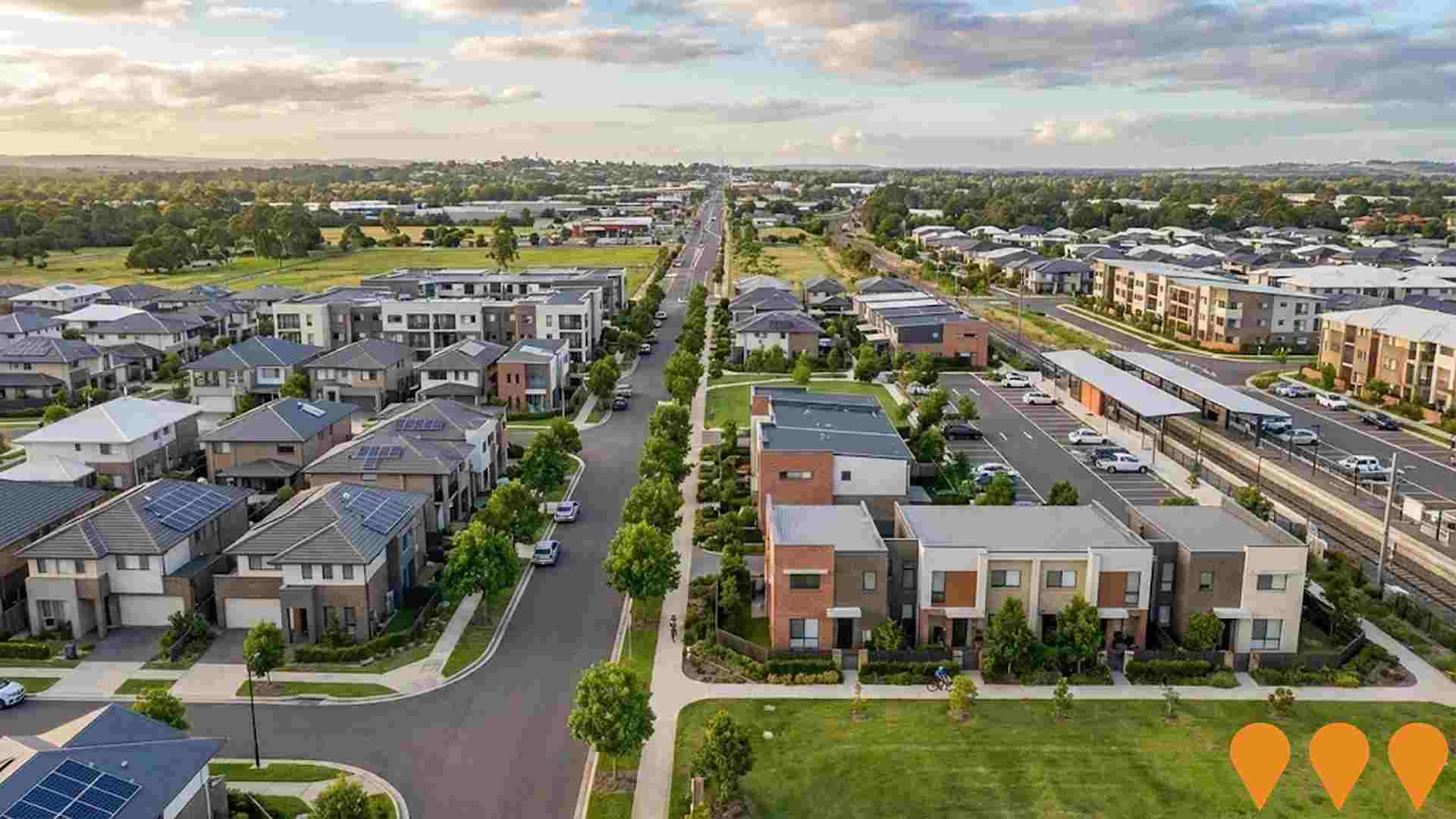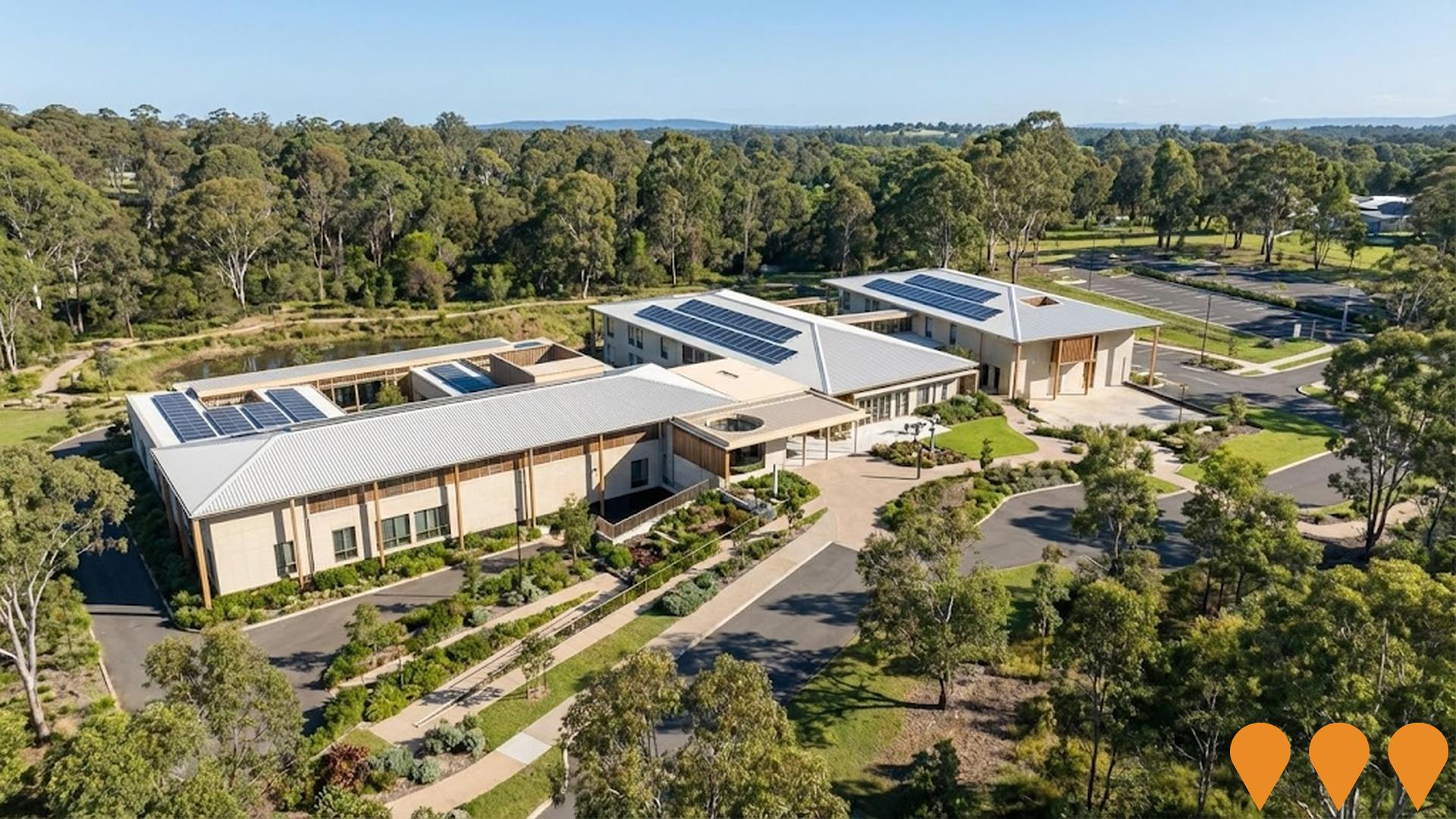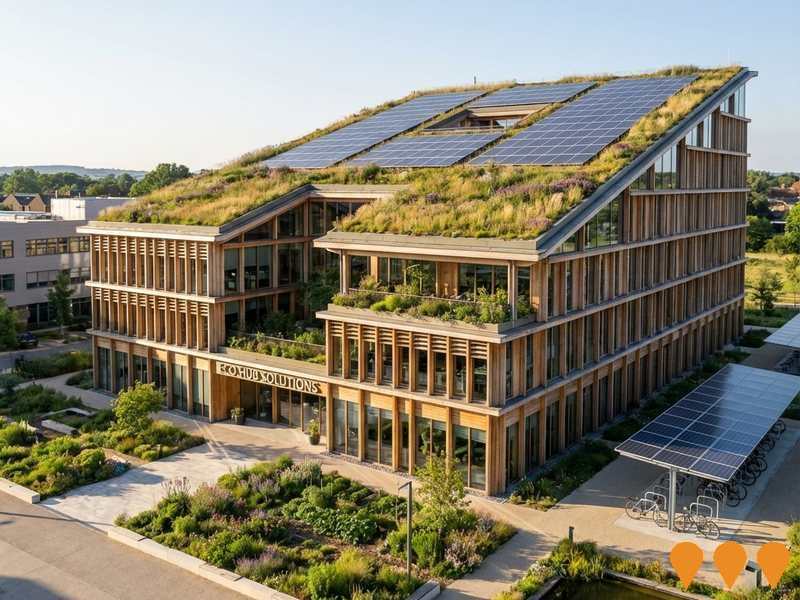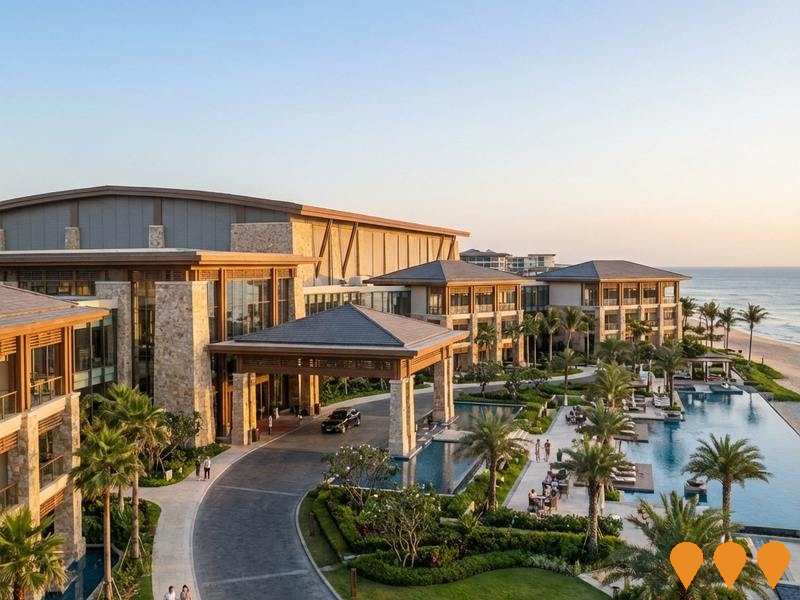Chart Color Schemes
est. as @ -- *
ABS ERP | -- people | --
2021 Census | -- people
Sales Activity
Curious about local property values? Filter the chart to assess the volume and appreciation (including resales) trends and regional comparisons, or scroll to the map below view this information at an individual property level.
Find a Recent Sale
Sales Detail
Population
Maitland - North lies within the top 10% of areas nationally in terms of population growth performance according to AreaSearch analysis of short and medium-term trends
Maitland - North's population is approximately 9,182 as of Aug 2025. This figure represents an increase of 455 people since the 2021 Census, which reported a population of 8,727. The growth is inferred from ABS estimates; Maitland - North had an estimated resident population of 9,162 in June 2024 and gained 20 validated new addresses since the Census date. This results in a population density ratio of 130 persons per square kilometer. Maitland - North's growth rate of 5.2% since the 2021 census exceeded the non-metro area average of 4.8%. Interstate migration contributed approximately 65.8% to recent population gains, with other factors also positive.
AreaSearch uses ABS/Geoscience Australia projections for each SA2 area released in 2024 with a base year of 2022. For areas not covered by this data, NSW State Government's SA2 level projections released in 2022 with a base year of 2021 are used. Growth rates by age group from these aggregations are applied to all areas for years 2032 to 2041. By 2041, Maitland - North's population is forecasted to increase by 3,982 persons, a gain of 43.1% over the 17-year period.
Frequently Asked Questions - Population
Development
Residential development activity is slightly higher than average within Maitland - North when compared nationally
Maitland - North recorded approximately 32 residential properties granted approval annually. Between FY-21 and FY-25164 homes were approved, with 11 more approved in FY-26 as of the current date. On average, 5.1 people moved to the area per dwelling built over these five financial years.
This high demand exceeds new supply, typically leading to price growth and increased buyer competition. New properties are constructed at an average expected cost value of $483,000. In FY-26, there have been $8.0 million in commercial approvals, indicating limited focus on commercial development compared to residential. Compared to the rest of NSW, Maitland - North has significantly less development activity, 69.0% below the regional average per person.
This scarcity of new homes typically strengthens demand and prices for existing properties. New building activity comprises 82.0% detached dwellings and 18.0% medium and high-density housing, maintaining the area's traditional low density character with a focus on family homes appealing to those seeking space. The estimated count of 644 people in the area per dwelling approval reflects its quiet, low activity development environment. Looking ahead, Maitland - North is expected to grow by 3,962 residents through to 2041. At current development rates, housing supply may struggle to match population growth, potentially heightening buyer competition and supporting price increases.
Frequently Asked Questions - Development
Infrastructure
Maitland - North has moderate levels of nearby infrastructure activity, ranking in the 48thth percentile nationally
Infrastructure changes significantly influence an area's performance. AreaSearch has identified 28 projects likely impacting the region. Notable ones include Sarroff's Shop Mixed Use Development, Hunterglen Drive Park Upgrade, 256 Paterson Road Subdivision, and 27 Lang Drive Subdivision. The following list details those most relevant.
Professional plan users can use the search below to filter and access additional projects.
INFRASTRUCTURE SEARCH
 Denotes AI-based impression for illustrative purposes only, not to be taken as definitive under any circumstances. Please follow links and conduct other investigations from the project's source for actual imagery. Developers and project owners wishing us to use original imagery please Contact Us and we will do so.
Denotes AI-based impression for illustrative purposes only, not to be taken as definitive under any circumstances. Please follow links and conduct other investigations from the project's source for actual imagery. Developers and project owners wishing us to use original imagery please Contact Us and we will do so.
Frequently Asked Questions - Infrastructure
Maitland Local Housing Strategy 2041
A comprehensive strategic planning framework adopted by Maitland City Council on 27 June 2023 and endorsed by the NSW Government on 9 September 2024. The strategy guides residential development and growth in the Maitland local government area through to 2041. It identifies areas for new housing, prioritizes infill development and housing diversity (including affordable housing) to meet the projected need for approximately 25,200 additional dwellings by 2041, and aligns infrastructure planning to support growth.

Hunter Valley Hydrogen Hub
The Hunter Valley Hydrogen Hub (HVHH) is a renewable hydrogen production facility, primarily developed by Orica. The initial phase involves a 50 MW electrolyser to produce approximately 4,700 tonnes of renewable hydrogen per annum, which will progressively replace natural gas in Orica's ammonia production on Kooragang Island to decarbonise their operations and produce low-carbon products. The project also includes a hydrogen refuelling network for the transport sector. Development approval was granted in May 2024, and the project is subject to a Final Investment Decision (FID).

Maitland Mental Health Rehabilitation Project
A purpose-built 64-bed mental health rehabilitation facility on the Maitland Hospital campus, featuring 24 low-secure forensic beds, 20 medium-secure forensic beds, and 20 high-support rehabilitation beds. The facility includes single bedrooms with ensuites, shared living spaces, therapy areas, and nature-integrated design with outdoor therapy spaces and walking paths. Designed by Bates Smart, the project will relocate and expand services from Morisset Hospital, supporting a transitional model of care with contemporary mental health services for adults in the Hunter region. Part of the NSW Government's $700 million Statewide Mental Health Infrastructure Program.

Sarroff's Shop Mixed Use Development
Alterations and additions to an existing building, involving demolition of rear structures and construction of new facilities (including a new toilet, cool room, and store room) for a mixed-use development, which formalises existing commercial uses: a cafe, restaurant, and real estate office, known locally as Sarroff's Shop. The development application DA/2024/636 was approved, and a modification (Section 4.55(1A)) to a condition was also lodged in August 2025.

Stockland Green Hills Expansion
A $414 million expansion that doubled the size of the shopping centre to 74,000 square metres, adding a second level with over 220 specialty stores including David Jones, H&M, Target, JB Hi-Fi, and The Courtyard outdoor dining precinct with LED light trees. The development features 3,125 car parking spaces and represents the largest retail redevelopment completed in Australia in 2018.

Maitland Regional Sports Complex Redevelopment
Comprehensive redevelopment of the existing sports complex including new grandstands, improved playing surfaces, upgraded facilities, and enhanced parking. The project will provide modern sporting facilities for the local community and regional competitions.

Melville Ford Bridge Replacement (Milton Morris Bridge)
Replacement of the existing low-level, one-lane timber bridge with a new dual-lane concrete bridge elevated approximately 6.7 metres higher to improve flood resilience, connectivity, and safety. The new bridge has been officially named the Milton Morris Bridge. Construction commenced in September 2024 but was delayed due to flood damage in May and August 2025 (erosion to abutments, displacement of deck beams, and debris). Repairs are underway as of November 2025, with beam reinstallation and deck construction resuming; completion date is to be confirmed.

256 Paterson Road Subdivision
Integrated Development Application (DA/2024/830) for the community title subdivision of one lot into 14 lots, comprising 13 residential lots and one community lot. The proposal includes associated civil works, vegetation removal, and the demolition of the existing structures. The lots range from 5,006 m2 to 5,521 m2. The site is zoned R5 Large Lot Residential.

Employment
AreaSearch analysis reveals Maitland - North significantly outperforming the majority of regions assessed nationwide
Maitland - North has an unemployment rate of 1.7%. As of June 2025, 4,653 residents are employed with an unemployment rate of 2.0% below Rest of NSW's rate of 3.7%.
Workforce participation is at 67.7%, higher than Rest of NSW's 56.4%. Leading employment industries include health care & social assistance, education & training, and construction. Mining shows strong specialization with an employment share 3.2 times the regional level, while agriculture, forestry & fishing is under-represented at 2.1% compared to Rest of NSW's 5.3%. Analysis from AreaSearch based on SALM and ABS data reveals a 4.1% decrease in labour force and a 4.5% decline in employment over one year ending June 2025, resulting in a 0.4 percentage point rise in unemployment rate.
Rest of NSW experienced an employment decline of 0.1%, labour force growth of 0.3%, and a 0.4 percentage point increase in unemployment during the same period. Jobs and Skills Australia's national employment forecasts from May 2025 project a 6.6% expansion over five years and 13.7% over ten years nationally, with local growth estimates for Maitland - North at approximately 6.3% over five years and 13.2% over ten years based on industry-specific projections.
Frequently Asked Questions - Employment
Income
The area exhibits notably strong income performance, ranking higher than 70% of areas assessed nationally through AreaSearch analysis
AreaSearch's latest postcode level ATO data for financial year 2022 shows Maitland - North's median income among taxpayers is $53,790, with an average of $68,191. This is higher than the national average and compares to Rest of NSW's median of $49,459 and average of $62,998. Based on Wage Price Index growth of 12.61% since financial year 2022, current estimates for September 2025 would be approximately $60,573 (median) and $76,790 (average). From the 2021 Census, household, family and personal incomes in Maitland - North rank highly nationally, between the 71st and 83rd percentiles. Income analysis reveals that 31.9% of residents (2,929 people) earn within the $1,500 - 2,999 weekly bracket, reflecting patterns seen in the surrounding region where 29.9% similarly occupy this range. Notably, 35.4% earn above $3,000 weekly. After housing costs, residents retain 87.0% of income, indicating strong purchasing power. The area's SEIFA income ranking places it in the 7th decile.
Frequently Asked Questions - Income
Housing
Maitland - North is characterized by a predominantly suburban housing profile, with above-average rates of outright home ownership
The dwelling structure in Maitland - North, as per the latest Census, consisted of 94.5% houses and 5.5% other dwellings including semi-detached homes, apartments, and 'other' dwellings. This is compared to Non-Metro NSW which had 87.1% houses and 13.0% other dwellings. Home ownership in Maitland - North stood at 38.3%, with mortgaged dwellings accounting for 48.3% and rented dwellings at 13.4%. The median monthly mortgage repayment in the area was $2,167, higher than Non-Metro NSW's average of $1,862. The median weekly rent figure was recorded at $420, compared to Non-Metro NSW's $375. Nationally, Maitland - North's mortgage repayments were significantly higher than the Australian average of $1,863, while rents were substantially above the national figure of $375.
Frequently Asked Questions - Housing
Household Composition
Maitland - North features high concentrations of family households, with a higher-than-average median household size
Family households account for 82.0% of all households, including 42.3% couples with children, 28.6% couples without children, and 10.8% single parent families. Non-family households constitute the remaining 18.0%, with lone person households at 16.5% and group households making up 1.5%. The median household size is 2.9 people, larger than the Rest of NSW average of 2.7.
Frequently Asked Questions - Households
Local Schools & Education
The educational profile of Maitland - North exceeds national averages, with above-average qualification levels and academic performance metrics
Maitland-North has a notably high educational attainment among its residents aged 15 and above. 26.1% of these residents hold university qualifications, surpassing both the SA4 region's 15.2% and the SA3 area's 17.6%. Bachelor degrees are the most prevalent at 18.1%, followed by postgraduate qualifications (5.0%) and graduate diplomas (3.0%). Vocational credentials are also prominent, with 41.0% of residents aged 15 and above holding such qualifications - advanced diplomas comprise 11.7% while certificates account for 29.3%.
Educational participation is high, with 31.6% of residents currently enrolled in formal education. This includes 11.2% in primary education, 9.5% in secondary education, and 4.2% pursuing tertiary education. The three schools in Maitland-North have a combined enrollment of 607 students. These schools focus exclusively on primary education, with secondary options available in surrounding areas. School capacity is limited locally (6.6 places per 100 residents compared to the regional average of 17.7), leading many families to travel for schooling.
Frequently Asked Questions - Education
Schools Detail
Nearby Services & Amenities
Transport
Transport servicing is moderate compared to other areas nationally based on assessment of service frequency, route connectivity and accessibility
Maitland-North has 67 active public transport stops offering a mix of train and bus services. These are covered by 39 routes that facilitate 1,059 weekly passenger trips in total. Residents enjoy excellent transport accessibility, with an average distance of 196 meters to the nearest stop.
Service frequency stands at 151 trips per day across all routes, translating to about 15 weekly trips per individual stop.
Frequently Asked Questions - Transport
Transport Stops Detail
Health
Health outcomes in Maitland - North are marginally below the national average with common health conditions slightly more prevalent than average across both younger and older age cohorts
Health indicators suggest below-average outcomes in Maitland - North.
Common health conditions are slightly more prevalent than average across both younger and older age cohorts. The rate of private health cover is fairly high at approximately 54% of the total population, which amounts to around 4930 people. Mental health issues and asthma are the most common medical conditions in the area, impacting 8.9 and 8.8% of residents respectively. 66.8% of residents declare themselves completely clear of medical ailments, compared to 63.4% across Rest of NSW. The area has 17.0% of residents aged 65 and over, which totals 1557 people, higher than the 15.4% in Rest of NSW. This is broadly in line with the general population's health profile.
Frequently Asked Questions - Health
Cultural Diversity
The latest Census data sees Maitland - North placing among the least culturally diverse areas in the country when compared across a range of language and cultural background related metrics
Maitland - North had a cultural diversity below average, with 92.3% of its population born in Australia, 94.8% being citizens, and 97.0% speaking English only at home. Christianity was the main religion, composing 60.6% of Maitland - North's population, compared to 57.0% across Rest of NSW. The top three ancestry groups were English (32.9%), Australian (32.0%), and Irish (9.5%).
Notably, Scottish ancestry was overrepresented at 8.6%, while Welsh and Australian Aboriginal were present at 0.6% and 3.1% respectively, differing from regional percentages of 7.6% and 5.1%.
Frequently Asked Questions - Diversity
Age
Maitland - North's population is slightly younger than the national pattern
The median age in Maitland - North is 38, which is lower than the Rest of NSW figure at 43 but equivalent to the national norm of 38. The 5-14 age group constitutes 15.9% of the population compared to Rest of NSW, while the 65-74 cohort makes up 9.6%. According to the 2021 Census, the 35-44 age group has grown from 13.6% to 15.0%, and the 15-24 cohort increased from 12.3% to 13.6%. Conversely, the 55-64 cohort has declined from 12.2% to 10.8%. Demographic modeling indicates that Maitland - North's age profile will significantly change by 2041, with the 45-54 group projected to grow by 58%, reaching 1,804 people from 1,144.


